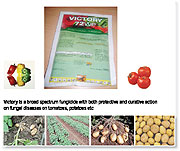There is a common misconception that rain affects crops like Irish potatoes and tomatoes in many rural areas of Rwanda. This is so common to the extent that farmers apply pesticides, mainly fungicides which control fungal diseases whenever it rains in these particular areas.


There is a common misconception that rain affects crops like Irish potatoes and tomatoes in many rural areas of Rwanda. This is so common to the extent that farmers apply pesticides, mainly fungicides which control fungal diseases whenever it rains in these particular areas.
However this misconception is not entirely wrong, because it is sourced from indigenous farmer knowledge from which many agricultural innovations have originated.
The connection between rain and fungal diseases is that wetness encourages the spread of fungal diseases like early and late blight.
High humidity and temperatures of between 18-22°C are ideal for development of this disease of late blight while for early blight, alternate wet and dry conditions are a predisposing factor also.
Fungal diseases like moisture, thus in dry seasons the instances of fungal diseases are very few, just as infestations of insect pests become more serious. Therefore rain comes with a spike in the spread of fungal diseases. In the most rain prone areas of Rwanda, namely the Northern Province areas of Musanze and Rubavu, where incidentally Irish potato is the most common food crop and the most widely crown crop, incidentally fungal disease attacks are very severe.
As opposed to common thinking rural farmers are not as ill-informed about good farming practices and control of pests and diseases.
For example it is well ground that a product called Mancozeb, Victory and Ridomil are the most popular products and sell well in the local agricultural input shops not only in areas where tomatoes and Irish potatoes are widely grown.
However the biggest problem is that Mancozeb which has only preventative properties but cannot treat the group of diseases that are targeted.
Yet this product has used for decades consistently in farms and therefore, the disease causing organisms shave developed a lot of resistance to the product.
Beside, this product because has been misused because of certain myths, for example of applying the product as frequent as after every two days as long as it rains.
Pesticide resistance among other things reduces the efficacy of the product. Since tomato is also in the same biological family as Irish potatoes, as well as egg plants, tomato, and chilli.
These diseases can cross infect from one of those crops to the other and therefore growing two of any of these crops together will encourage more severe attacks by the diseases.
The problem of resistance can be avoided by alternating products that do the same job and that applies for all kinds of pesticides.
This is why in order to control these diseases effectively, products like Ridomil or Victory which contain mancozeb and another ingredient called metalaxyl which has treatment instead f preventive properties, control the fungal diseases more effectively.
To achieve a more balanced effective control of diseases fungicides should be alternated in different seasons or in different sprays of the same season. Mancozeb, used in combination with Victory provides a most effective solution to control of major diseases in Irish potato and tomatoes.
Besides, these products used in combination offer a more spaced spray interval up to 14 days between sprays and therefore reduce the environment’s exposure to chemicals and reduce the farmer’s overall cost of farming, hence increasing the farmer’s profit.


